Bunak in Timor-Leste

Photo Source:
David Palazón - Wikimedia
Creative Commons
|
Send Joshua Project a map of this people group.
|
| People Name: | Bunak |
| Country: | Timor-Leste |
| 10/40 Window: | Yes |
| Population: | 76,000 |
| World Population: | 101,000 |
| Primary Language: | Bunak |
| Primary Religion: | Ethnic Religions |
| Christian Adherents: | 23.00 % |
| Evangelicals: | 3.00 % |
| Scripture: | Translation Started |
| Ministry Resources: | No |
| Jesus Film: | No |
| Audio Recordings: | No |
| People Cluster: | Timor |
| Affinity Bloc: | Malay Peoples |
| Progress Level: |
|
Introduction / History
The Bunak language, which is also called Bunak, is not closely related to any other language. According to their oral legends, the Bunak people started with two brothers who were domesticating water buffalos. They found two female water buffalos that turned into women. One of the brothers took both women as his wife, leading to fighting and separation between the two brothers. Their neighbors consider the Bunak to be fighters and squabblers, so the traditional story explains some things about what they value.
The Portuguese settled on Timor in the early 1500s, and Dutch traders first landed on the island in 1613. The Portuguese and Dutch competed for influence until a series of agreements established boundaries between their holdings. Dutch Timor, centered in the west, became part of the Republic of Indonesia in 1950. Portuguese Timor, centered in the east, was forcibly annexed by Indonesia in late 1975. Today the Bunak people live on either side of the border.
What Are Their Lives Like?
The economy of Timor is dominated by agriculture. Cultivation is by traditional methods, and the chief products are maize, rice, coffee, fruit and copra (dried coconut meat-yielding The coastal inhabitants of Timor predominantly descend from Indonesian-Malay ancestry. They have driven the predominantly Melanesian aborigines (such as the Bunak) to the mountains.
Bunak villages often consist of individual settlements. In the mountains, the people live on swiddens (land that has been cleared by "slash and burn" agriculture) for part of the year. After harvesting the crops, however, they return to their home villages.
Each village has a sacred house, a custodian priest, and a surrounding taboo area. Due to past coastal warfare, villages and isolated houses are surrounded by stockades.
Bunak descent is traced through both the males and females and the circle of kinship is divided into various sub-groups. The center, however, is the nuclear family, composed of a man, woman and their children.
Other Bunak people are urban. They have been lawyers, political activists, artists, musicians and athletes.
What Are Their Beliefs?
The Bunak practice ethnic and animistic religions (belief that non-human objects have spirits). They also practice ancestor worship (praying to deceased relatives for guidance, blessing and protection). A strong minority of the Bunak people in Timor-Leste are Christian believers who can potentially reach others for the only savior.
What Are Their Needs?
The Bunak have few Christian resources available in their own language. Bible materials need to be translated into their language, and they need to learn to disciple others who will disciple even more people in Christ's ways.
Prayer Points
Ask the Lord to send loving Christians to help Bunak to minister the peace of Jesus to every Bunak family.
Pray that signs and wonders will follow the Bunak believers as they share Christ.
Pray for the Holy Spirit to give the Bunak people a spiritual hunger that will drive them to the cross and the empty grave.
Ask the Lord to bring forth a strong Bunak church that will plant more churches.